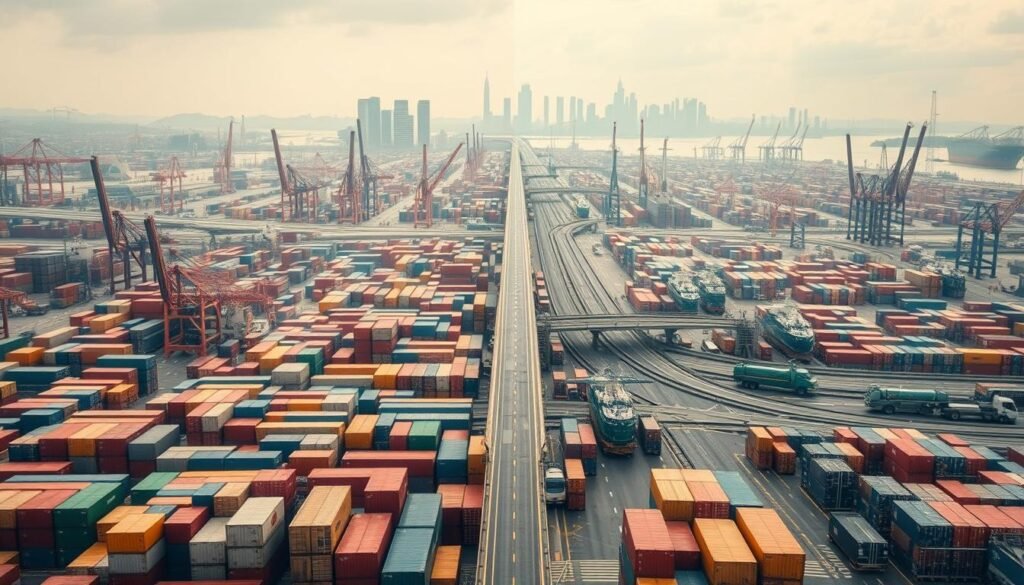Trump’s Tariff: Understanding Global Impacts and Implications
Did you know Trump’s tariffs have changed billions of dollars in global trade? They have had a big impact on many sectors and economies worldwide. The Trump administration wanted to fix trade imbalances and protect American jobs. But this trade war has affected more than just the U.S., changing how countries trade with each other.
Trump’s tariffs have changed how countries trade and their economic relationships. They have touched every part of the trade world, from cars to farms. This introduction will explain how these tariffs have changed the economy.
Key Takeaways
- Trump’s tariffs have influenced billions of dollars in international trade.
- The aim was to correct trade imbalances and safeguard American industries.
- Global tariffs triggered significant changes in trade policies and relations.
- Both the U.S. and global markets experienced substantial economic impacts.
- Multiple sectors, including automotive and agriculture, were noticeably affected.
The Background and Origin of Trump’s Tariffs
The story of Trump’s tariff policy starts with his campaign promises. He wanted to fix what he saw as unfair trade practices. He aimed to protect American businesses and workers from foreign competition.
President Trump started making changes soon after taking office. In early 2018, he introduced tariffs on steel and aluminium. He said it was for national security, to keep vital materials for defence.
The Trump administration had big goals. They wanted to cut the U.S. trade deficit, mainly with China. They also wanted to boost domestic manufacturing. Tariffs were seen as a way to get other countries to agree to better trade deals.
Also, these moves were political. Trump aimed to win over voters who felt left out by globalization. He framed Trump’s tariff as a way to protect American jobs and industries.
Trump’s tariffs marked a big change in US trade policy. Unlike past policies that focused on free trade, Trump’s approach was more protectionist. This change showed a new way for America to protect its economic interests in the global market.
Economic Consequences of Trump’s Tariffs
President Trump’s tariff policies have had a big impact on the U.S. economy and global markets. They have changed how countries trade with each other. This has affected the prices of goods and the overall economy.
Impact on the U.S. Economy
The tariffs have made it more expensive for U.S. companies to make goods. This has led to job losses in some areas. But it has also created jobs in other sectors.
The tariffs have also made the U.S. GDP go up and down. This is because of the changes in trade with other countries.
Effect on Global Markets
The tariffs have caused problems for global markets. They have changed trade balances and made markets unstable. Companies with operations in many countries have faced challenges.
Countries hit by the tariffs have raised their own tariffs. This has made global trade even more complicated.
Revenue Generated from Tariffs
Trump’s tariffs have brought in a lot of money. This money was meant to help the U.S. economy. But, there are questions about whether the money is enough.
Experts are watching how the tariffs affect the economy. They want to know if the benefits last long term or are just short-term gains.
The Impact on U.S. Households
The trade war has hit many U.S. households hard. It has raised the cost of living and made finances less stable. Looking at how tariffs affect prices, income, and inflation helps us understand the impact.
Rising Costs of Consumer Goods
Tariffs on imported goods have made everyday items more expensive. Electronics, clothes, and even food have seen price increases. This puts a strain on household budgets and adds to the economic burden.
Changes in Household Income
Household incomes have also been affected by the trade war. The economic strain on businesses has led to job losses and reduced hours in some sectors. At the same time, wages have not kept up with inflation, making it harder for families to make ends meet.
Inflationary Effects
The trade war has also led to higher inflation. Tariffs have increased production costs, pushing prices up across the economy. This inflation reduces household purchasing power and can lead to less spending by consumers.
| Consumer Goods | Pre-Tariff Cost | Post-Tariff Cost |
|---|---|---|
| Electronics | $1,000 | $1,150 |
| Apparel | $50 | $60 |
| Groceries | $200 | $220 |
Retaliatory Tariffs from Trading Partners

The trade war started when the Trump administration put tariffs on imports. This led to retaliatory tariffs from major trading partners. These actions strained international trade agreements and hurt both sides economically.
China’s Response
China hit back with its tariffs on American goods. These tariffs affected agriculture, like soybeans, hard. This made the trade war worse, pushing both sides to talk about a new trade deal.
Retaliation from Canada and Mexico
Canada and Mexico, important NAFTA partners, also put up tariffs. Canada’s tariffs targeted steel, aluminium, and more. Mexico’s tariffs hit pork and cheese, making trade harder in North America. They wanted fairer trade.
The European Union’s Reactions
The European Union also retaliated with tariffs on American goods. They targeted bourbon, motorcycles, and orange juice. This showed the EU’s commitment to protecting its economy. It highlighted the need for strong trade agreements to avoid such conflicts.
Specific Country Impacts: Case Studies
Looking at Trump’s global tariffs shows how each country is affected. Our country-specific analysis shows different effects based on trade, sectors, and the economy.
China has been hit hard by trade negotiations and global tariffs. The U.S. tariffs hit tech and manufacturing, cutting China’s exports. China now focuses more on Europe and Southeast Asia.
Canada
Canada’s story is complex. Tariffs on steel and aluminium hurt Canadian metal makers. Canada also hit back with tariffs on U.S. goods, showing how trade ties between the two countries are tight.
Mexico
Mexico, close to the U.S., felt the pinch in autos and farming. It had to tweak trade negotiations to soften the blow. This shows the need for strong trade policies.
The European Union
The EU faced big challenges with global tariffs, hitting autos and luxury goods. The EU fought back in trade negotiations and sought new markets to make up for lost U.S. sales.
Our study shows how global tariffs affect countries differently. Country-specific analysis is key to grasping the economic and political fallout.
IEEPA: Border Security and Fentanyl Tariffs Explained

The Trump administration used the International Emergency Economic Powers Act (IEEPA) to boost border security and fight the fentanyl crisis. This move allowed for a quick and strong response to illegal drug trafficking and other threats.
The main goal was to stop fentanyl from entering the U.S. Tariffs were put on countries linked to illegal fentanyl supply chains. These tariffs aimed to disrupt these networks and push foreign governments to fight drug trafficking more.
The legal basis for these actions is the wide powers given to the president by IEEPA. This act lets the executive branch control international trade in emergencies that threaten the U.S. security, foreign policy, or economy.
But there have been legal fights over these tariffs. Trade partners and domestic groups have questioned their legality. They worry about how these actions fit with international trade laws and agreements.
Despite these issues, using IEEPA for fentanyl tariffs shows a big shift in policy. It mixes economic tools with national security goals. This approach shows how trade policies and border security efforts can tackle the fentanyl crisis.
While the success of these tariffs in stopping drug trafficking is debated, they show a proactive use of economic sanctions. They aim to achieve bigger security goals.
Impact on Key Industries
The Trump administration’s steel, automotive, and agricultural tariffs changed the U.S. economy a lot. These tariffs were meant to help U.S. industries, but they affected costs, supply chains, and global competition. We’ll look at how these tariffs impacted the steel and aluminium, automotive, and agricultural sectors.
Steel and Aluminium Sectors
Steel tariffs hit the U.S. steel and aluminium hard. They were meant to help U.S. makers, but made raw materials more expensive. This made it tough for U.S. companies to compete worldwide.
Here’s a table to show the impact:
| Impact | Pre-Tariff | Post-Tariff |
|---|---|---|
| Steel Prices (per ton) | $700 | $900 |
| Aluminium Prices (per pound) | $0.80 | $1.00 |
| Domestic Production | Stable | Increased |
Automotive Industry
The automotive industry saw big changes with automotive tariffs. Car makers paid more for parts from abroad, raising costs. This made cars pricier and hurt U.S. car makers’ profits.
Trade uncertainty also made car makers rethink their plans. This changed the car industry a lot.
Agricultural Sector
Agricultural tariffs hurt U.S. farmers a lot. Soybeans, pork, and dairy faced big export hurdles. This led to too much produce and lower prices at home.
Exports dropped, putting a squeeze on farmers’ finances. Many farmers had to find new ways to keep going. These tariffs also changed how farmers planned their crops.
In summary, tariffs on steel, cars, and farms show how these industries are connected. They highlight the need for smart trade policies for a stable economy.
Trade Negotiations and Trade Deals
Trump’s tariffs have changed the world of trade talks. These steps were taken to balance trade. They led to key international agreements and deals.
U.S.-China Trade Deal
The U.S.-China trade deal is a big win in recent talks. It helped reduce trade fights. It tackled issues like stealing ideas, technology sharing, and trade gaps.
This deal aimed to make the economic ties between the two powers better. It wanted to keep global markets stable.
NAFTA and USMCA Implications
NAFTA, changed to the USMCA, brought big changes to North America’s trade. The new deal has tougher rules for workers and the environment. It also lets American farmers sell more dairy in Canada.
It updated trade rules for the digital age. NAFTA didn’t cover this well.
Impact on EU Trade Negotiations
Trump’s tariffs have also affected talks with the European Union. The EU put tariffs on steel and aluminium. This made them want fair trade.
The talks show how hard it is to make deals that help everyone. This is all happening with protectionist policies around.
Tariff Exemptions and Special Considerations
Understanding tariff exemptions and special considerations is key to grasping trade policy changes. These tools help certain industries and countries deal with tariff costs. By looking at who gets these exemptions, we learn more about global trade.
Exemptions are given for goods needed for national security or hard to find at home. Tech and manufacturing often use these to stay competitive. For example, Apple might get exemptions for parts not made in the U.S.
Countries close to the U.S. or with big trade deals get special treatment. This boosts trade and economic stability. Canada and Mexico, for example, get tariff breaks under the USMCA, helping many sectors.
The success of tariff exemptions and special deals affects how tariffs are seen. They aim to protect U.S. industries but can also help consumers and businesses. It’s a tricky balance, and knowing these details is important for understanding trade policy changes.
Legal Challenges and Court Rulings

Exploring Trump’s tariffs, we find ourselves in a complex world. It’s vital to look at the legal challenges and court decisions that have shaped these tariffs. Many lawsuits have been filed, questioning if these tariffs are legal under current trade law. This has led to important court decisions.
Court of International Trade Rulings
The Court of International Trade (CIT) has been key in reviewing these legal challenges. In a major case, the CIT looked into whether the President went too far with Section 232 of the Trade Expansion Act of 1962. The ruling shed light on trade law, showing the fine line between national security and economic effects.
Appeals and Ongoing Legal Battles
Even with the CIT’s decisions, the legal journey is far from over. Many cases have moved to appeals, seeking a second look from higher courts. These ongoing battles show the complexity and changing nature of trade law. The results of these appeals could set big precedents for future tariffs, making them a critical part of U.S. trade policy.
Predicted Long-term Effects on International Trade Policy
Trump’s tariff policy is expected to change international trade policy a lot. Experts say we will see big changes in how countries trade with each other. It’s important to understand these changes to see their full impact.
First, we think global trade alliances will change a lot. Countries hit by U.S. tariffs might team up with new partners. This could make them less dependent on the U.S. and create new, strong trade groups.
Next, trade agreement standards might get stricter. Countries might put up more barriers to protect their economies. This could lead to higher tariffs and challenge the idea of free trade that’s been around for years.
The economic effects of these changes are also big. Tariffs and trade wars can cause long-term economic problems. Businesses might have to pay more and face supply chain issues. This could make things more expensive for consumers and slow down economic growth.
Looking at these changes, we see how complex and connected modern trade is. As these effects happen, we need to keep watching and make smart moves to deal with the changing trade policy world.
Comparing Pre- and Post-Tariff Trade Scenarios

Looking at trade before and after Trump’s tariffs shows big changes. These changes affect trade volumes, economic growth, and how well industries do. By using economic forecasts and trade policy analysis, we can see how these changes hit the U.S. and the world.
| Year | U.S. Trade Volume (Billion USD) | Global Trade Volume (Billion USD) | U.S. GDP Growth Rate (%) |
|---|---|---|---|
| Pre-Tariffs (2016) | 3,800 | 18,000 | 2.9 |
| Post-Tariffs (2019) | 3,500 | 17,500 | 2.3 |
The numbers show a drop in trade and slower growth after tariffs. This change is clear in both U.S. and global trade. It shows how tariffs have reshaped the trade world.
Looking closer, we see certain industries like cars and farming were hit hard. This shows the wide reach of these changes. By studying these changes, we get a full picture of how tariffs have affected trade.
Global Economic Outlook Under Trump’s Tariffs
The Trump administration’s tariffs have sparked a lot of debate. People are looking at how they affect the global economy. We see both short-term market reactions and long-term economic changes.
Short-term Forecasts
Right after tariffs were put in place, the economy showed mixed signs. Some U.S. industries did better because of the tariffs. But this made things more expensive for consumers. The world markets also saw ups and downs, showing the uncertainty and changes in trade.
Long-term Projections
Looking ahead, the effects of tariffs are complex. Some sectors might do well, but others could struggle for a long time. The future of the economy depends on how countries adjust their trade plans.
If tariffs stay, countries might look for new trade partners or grow their products. This could change how trade works around the world.
Alternative Economic Policies
With tariffs causing problems, new ideas for fixing the economy have come up. People talk about better trade deals, helping U.S. industries grow, and working with other countries. These plans could help the economy stay stable and grow over time, even with tariffs.
Conclusion
As we wrap up our detailed look at Trump’s tariffs, it’s evident that they’ve had a big impact on both the U.S. and the world. Trump’s goal was to help American industries and keep jobs here. But the effects have been wide and complex.
In the U.S., families paid more for everyday items and saw changes in their income. Industries like steel, aluminium, cars, and farming were hit hard. This led to different reactions and plans from companies. The money made from tariffs was a mixed blessing for the economy.
Abroad, countries like China, Canada, Mexico, and the EU fought back with their tariffs. This led to tough talks and new trade deals, like the USMCA. The future of global trade will depend on how these changes are handled. We’re keeping a close eye on these shifts to help shape better trade policies.




